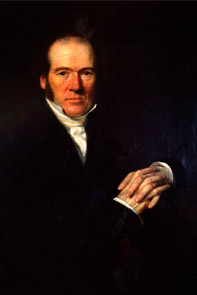Walter Newall
Walter Newall | |
|---|---|
 Portrait of Walter Newall | |
| Born | 3 April 1780 Doubledyke, New Abbey, Kirkcudbrightshire |
| Died | 25 December 1863 (aged 83) Craigend, New Abbey, Kirkcudbrightshire |
| Nationality | Scottish |
| Occupation | Architect |
| Buildings | Moat Brae, Dumfries Hannayfield, Dumfries Glenlair , Kirkcudbrightshire The Observatory, Dumfries Assembly Rooms, Dumfries Moffat Town Hall (originally the Pump House & Baths) Cardoness, Kirkcudbrightshire |
Walter Newall (3 April 1780 – 25 December 1863) was a Scottish architect and civil engineer, born at Doubledyke in the parish of New Abbey in the historic county of Kirkcudbrightshire, Scotland. He was the leading architect in the Dumfries area, from the 1820s until his retirement.[1] He trained James Barbour who succeeded him as principal architect in the region.[2]
Career
Newall began his design career in partnership with an
Throughout his working life he lived mainly in Dumfries, travelling around Dumfriesshire, Kirkcudbrightshire and Wigtownshire in the course of his work. His papers show him to have made tours of Germany and Italy, as well as parts of England, notably Oxford, Cambridge and Fonthill. The architects John Edgar Gregan (1813–55), William Reid Corson (1821–86), his brother George Corson (1829–1910) and James Barbour (1834–1912) all served as apprentices under Newall.
Newall died at Craigend, New Abbey, on Christmas Day, 1863. An extensive archive of Newall's sketchbooks, drawings and plans have survived and were purchased by Dumfries Museum in the spring of 1991. Newall is buried in St. Michael's Churchyard, Dumfries.
Works
His built works included villas at Cardoness (1828), for Sir David Maxwell, Baronet, and
Gallery
-
Gravestone of Walter Newall, St. Michael's Churchyard, Dumfries
-
Southerness Lighthouse (1842-3), Solway Firth
-
The Observatory (1836), Dumfries
-
Anwoth Church (1826), Kirkcudbrightshire
-
Kilquhanity House (1820), Kirkpatrick Durham
-
Moat Brae (1823), Dumfries
-
Assembly Rooms (1825), Dumfries
-
Nith House (1828), Irish Street, Dumfries (now the Albert Club)
-
Moffat Town Hall (originally the Pump House & Baths)
External links
- The Peter Pan Moat Brae Trust.
- "Walter Newall". Dictionary of Scottish Architects 1840-1940. Retrieved 30 June 2008.
References
- ^ a b c Colvin, Howard, (1978) A Biographical Dictionary of British Architects, 1600–1840, John Murray, pp.697-699
- ^ "Dictionary of Scottish Architects - DSA Architect Biography Report (August 16, 2020, 10:22 am)". www.scottisharchitects.org.uk. Archived from the original on 20 July 2016. Retrieved 16 August 2020.









